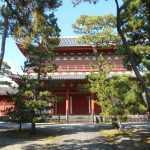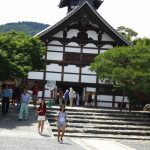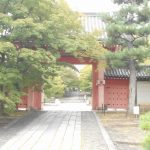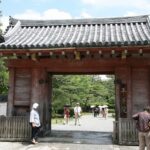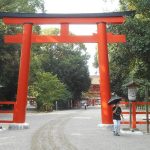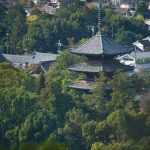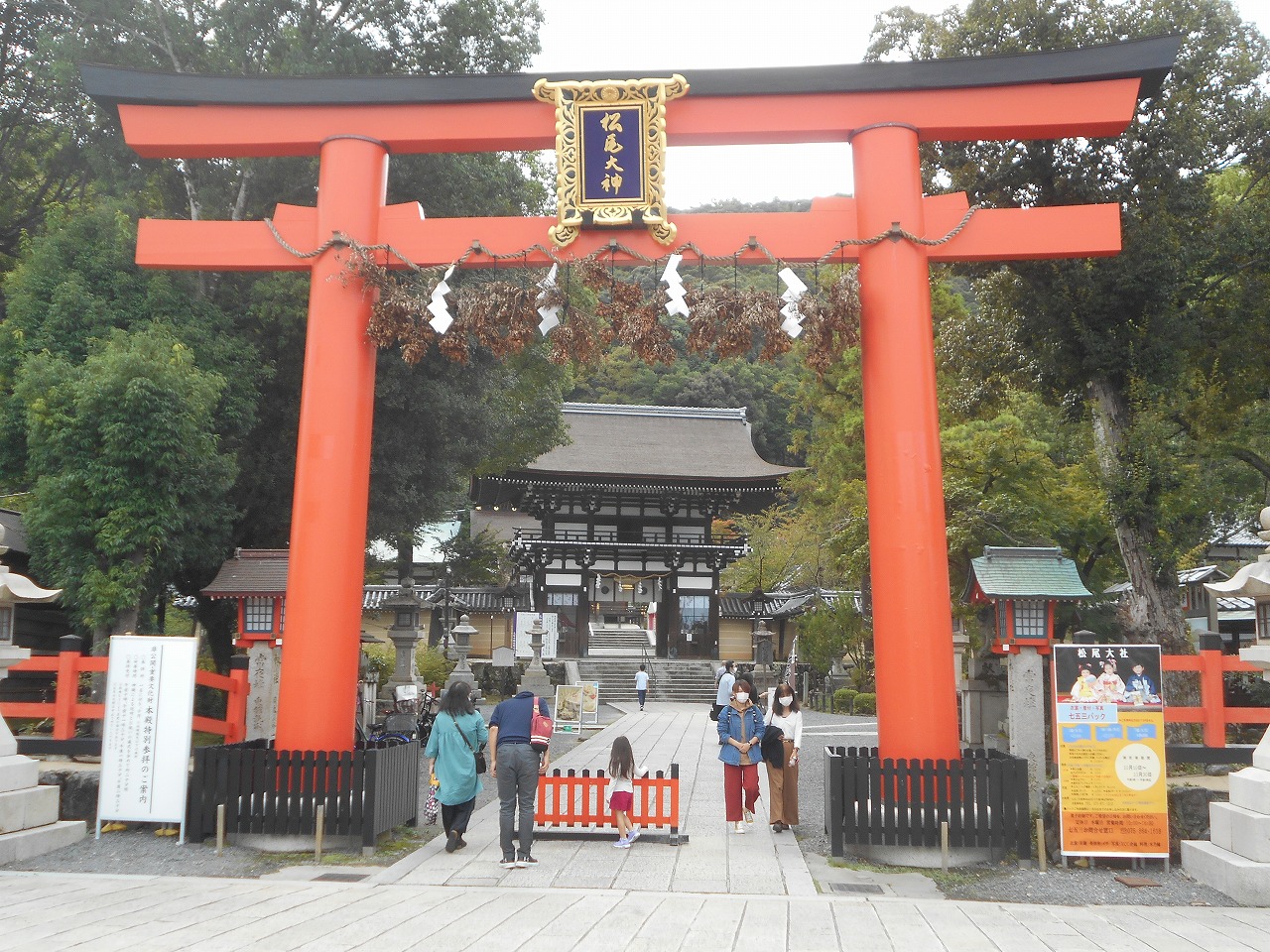
ページの目次
Matsunoo Taisya Shrine(松尾大社)
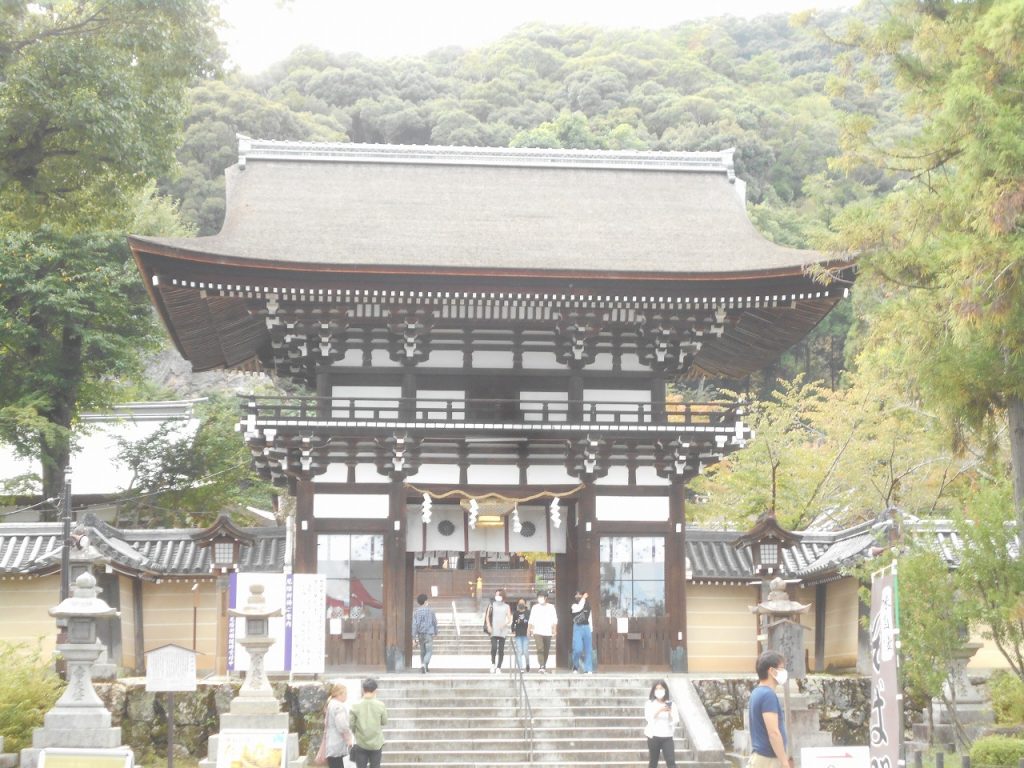
1. Location-Access
This shrine is located in western area of Kyoto,at the foot of Matsuoyama Montain. And it has a vast ground of 120,000 Tubo in th scene district. You can reach the shrine’s approach by crossing the Matsuo Bridge on Katsura river and passing throufh the huge Torii shrine’s gate.
It takes 40 minutes from Kyoto station to Matsuo-taisya-mae by Kyoto city bus #28.
(この大社は、京都西部、松尾山山麓にあり、全域が風致地区の約12万坪の広い境内に位置
する。京都市中心を走る四条通りの西の端にあり、桂川に架かる松尾橋を渡り、大鳥居を潜ると参道である。市バス系統#28で京都駅から松尾大社前まで、約40分要する。)
2. Who was this shrine built?
1) In 701 of Nara period, it is said that Kufuntori Hata invited the holy spirit of Iwakura at Matsuoyama Otani and established the base of this shrine.
The principality is Oyamakui-no-kami, Nakatsushimahine-no-mikoto.
(701年、奈良時代、渡来人秦忌寸都理が松尾山大杉谷の磐座の神霊を呼んだ。
本尊は大山昨神、市杵姫命である。)
2) This shrine was called a guardian of agriculutere and civil engineering, based on their Hata Family’s strong sake brewing.
And so Matsuo Taisya was developing with the support of Court and Hata.
(秦一族の特技である酒造りをベイスにし、松尾大社は農業、土木工事の守り神と仰がれた。
さらに、朝廷と秦氏により松尾大社は発展していった。)
3) During Heian period, the shrine obtained lots of religious faith as protective deity of Royal Family. By the middle age the shrine was known for a worship ground for god of brewing.
(平安時代には、この寺は皇城鎮護の神として多くの信仰を集めていた。中世以降は、醸造の神として、信仰を得ていた。)
4) After Kamakura period, this shrine was honored by the Samurai and praised fontain called “Kamenoi”. It gathered people’s religions as a brewing god.
(鎌倉時代以降には、武士の崇敬を受け、「亀の井」と言われる境内の霊泉を讃え、醸造の神として人々の信仰を集めた。)
5) In Muromachi period, the main hall had a very uncommon architecture which is called “Matsuotukuri” and it was reconstructed in 1542.
(室町時代では、本殿が1542年に再建された「松尾造り」と呼ばれる珍しい建築であった。)
3. What is this shrine famous for ?
1) Japanese Sake Brewing and Spring Water 日本酒と霊泉
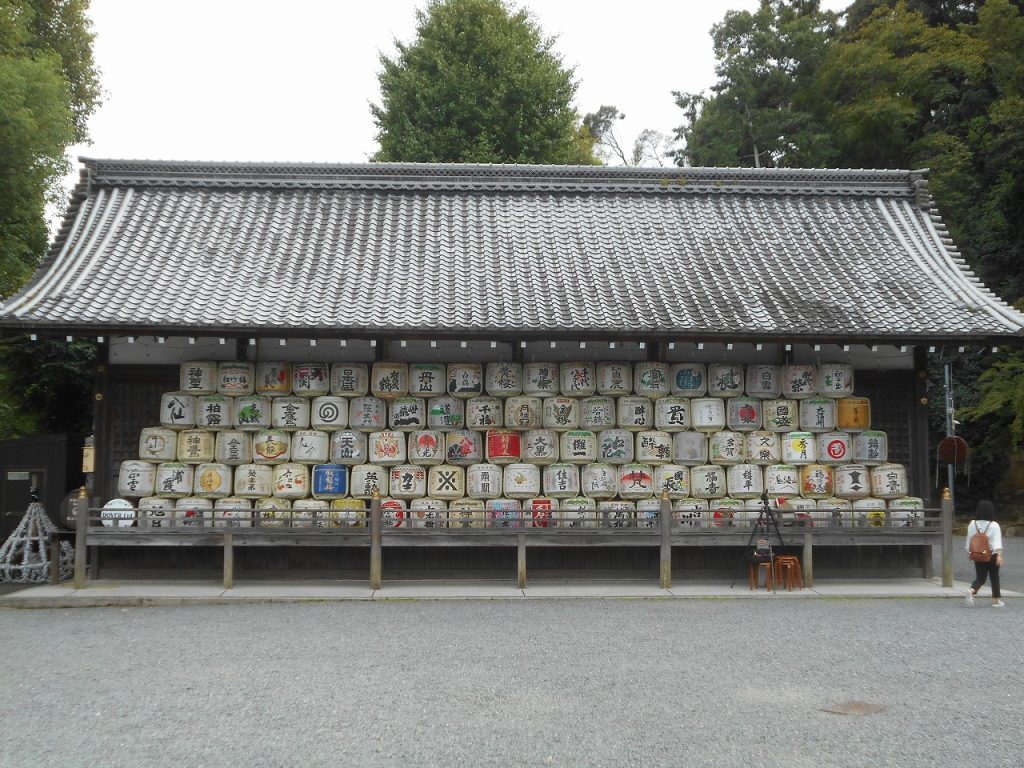
① Sake barrels are piled up in many layers.
The god at Matsuno-o Taisya Shrine is famous as a god sake making.
Those barrels are all offerings from sake makers from all over Japan.
In April, Chuyusai is held on a thanking for brewing.
(たくさんの樽が積み上げられている。松尾大社はお酒の神様として有名である。全国の
酒造家から奉納されたものである。また、4月には、醸造感謝祭の「中酉祭」がある。)
② That’s why there are so many different brand names. The kamenoi well in this shrine is well known for very good spring water. It’s also said that using this water gives the sake an excellent taste.
(いろんな銘柄がある。境内の「亀の井」は名水として知られていて、この水を使うと良いお酒にあると言われている。)
2) Shinkou and Kankosai Festival 神幸祭と環幸祭
① Matsuo Festival, Shinkousai in April is one of largest ceremony. A mikoshi which is 6 portable shrines crosses the Katura river on boats from Katsura Palace to these shrines which this is called “Oide”.
(4月の松尾祭、神幸祭は、盛大な祭りである。桂離宮からこの大社まで、桂川を船で漕いで渡り6基の神輿を運ばれる神幸祭“おいで”が行われる。)
② In May of Kangensai, the retering of mikashi cross the Matsuo Bridge in called “Okaeri”. The shrine is very popular for weldings and the seven-five-three year’s old festival as well.
(5月の環幸祭“おかえり”は松尾橋を通って帰る行事である。
また、この神社は結婚式、七五三の祝いが有名である。)
4. What is highlight?
1) Ancient Faith 太古からの信仰
Mt. Matsuo has been worshipped as a mountain where god lives by people living in this area. At the top of Oushugi valley near the peak, there is a stone called “Iwakura” and the stone was enshrined as guardian god of life.
(松尾山は昔からこの地に住む人々が神様の住む山として崇め信仰してきた。頂上に近い
大杉谷の上部には磐座と呼ばれる岩があり、生活の守護神として崇敬してきた。)
2) Large Torii Gate 大鳥居
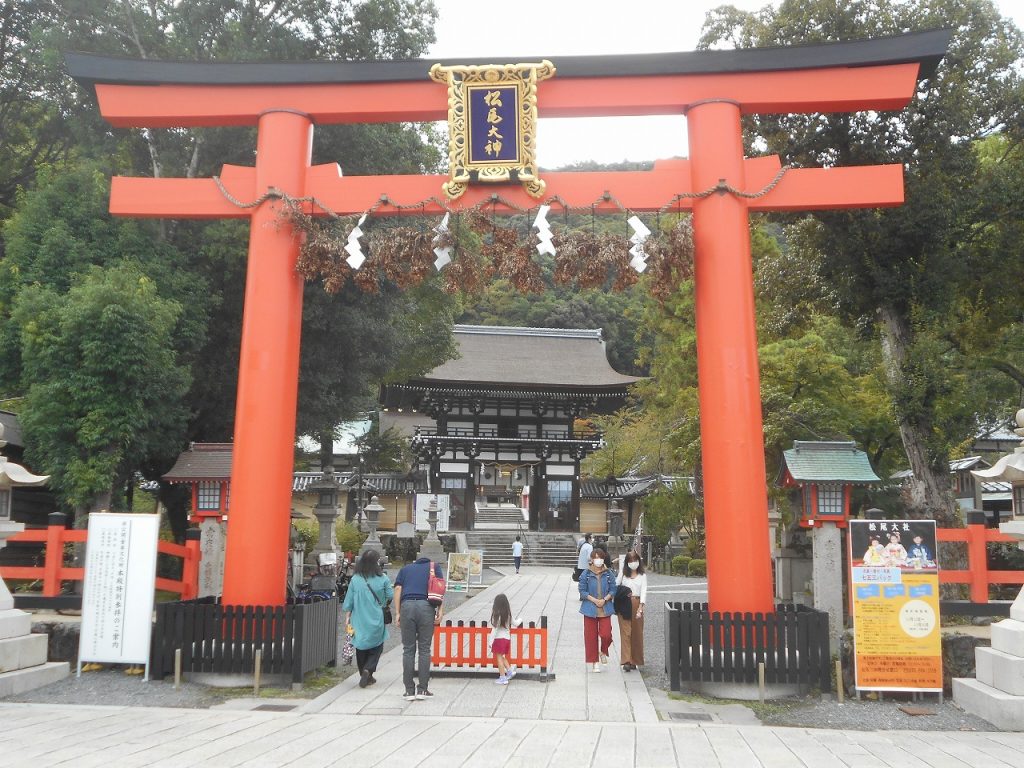
There is a large Torii gate in front of Hankyu-matsuotaisya station. This temple conforts the east Yasaka shrine, surrounding Katsura river and green mountain.
(阪急松尾大社前に、大鳥居が建ち訪問者を出迎えている。桂川と蒼い山々に囲まれた神社で、東の八坂神社を対峙する。)
3) Roumon (Tower gate) 楼門
There is a splendid tower gate in passing the approach, was built 1667 with 11m height.
It’s a building in Irimoya-Tsukuri style and clay tile roofing arranged gods on the left and right.
(参道を進むと立派な楼門は高さ11m、1667年建立された。 檜皮葺の入母屋造りの建物であり、左右に随神を配置されている。)
4) Haiden & Main Hall 拝殿と本殿
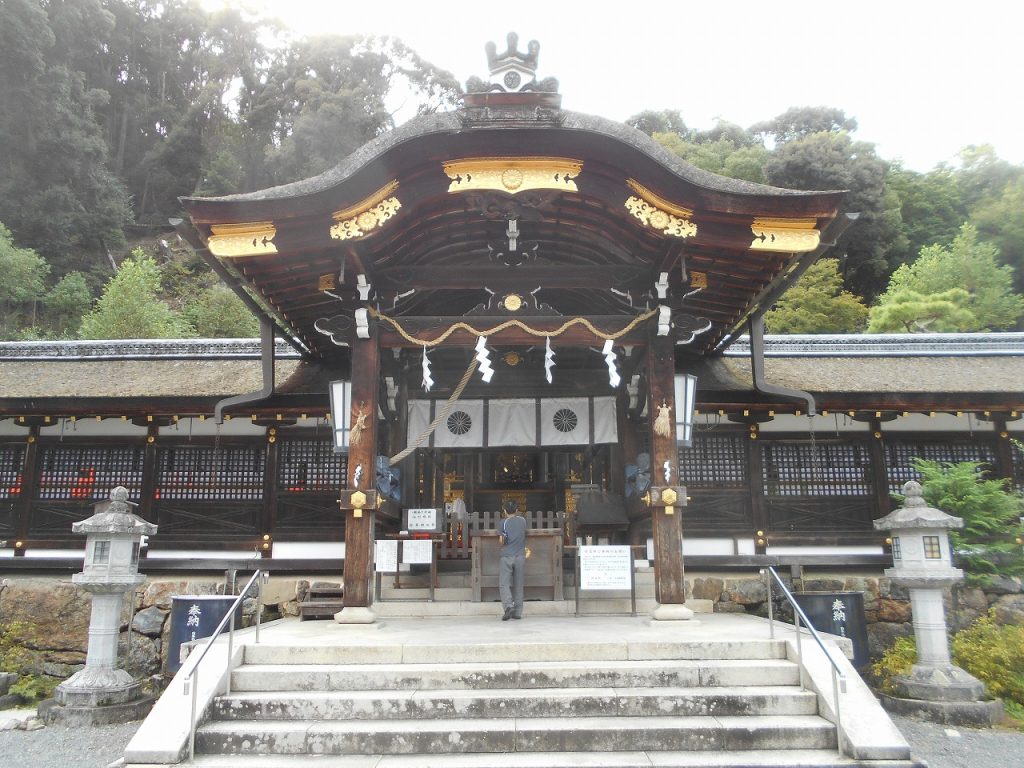
Worship Hall was built in early Edo period in front of Roumon, Main Hall was burnt down in 1285. The present was rebuilt in 1397, Muromachi period.
In 1942, major repairs were made.
It has both Nagare-zukuri but it has an architectural style similar to that of gobbles.
(楼門の正面には拝殿があり、江戸初期に建てられた。本殿は1285年に焼失し、現在のものは、室町時代1397年建てられ、1942年大修理が行われた。
両流れ造りだが、切妻造りに似た建築様式である。)
5) Shofu-en 松風苑
There is 3 famous garden of “Kyokusui-en-no-wa”, “Hourai-no-wa” and “Gyogo-no-wa”.
It called “Shofu-en”, made by Mirei Shigemori in 1975.
Kyokusui-en-no-wa express place of elegance that nobles are used to.
Hourai-no-wa represent Mt. Hourai where the hermit lives.
Gyogo-no-wa is ancient style before Asuka period to be Mt. Matsuo’s Iwakura.
(1975年重森三玲が作庭した松風苑と呼ばれる名園で、曲水の庭、蓬莱の庭、上古の庭の3つの庭園がある。曲水の庭は、貴族が慣れ親しんだ雅遊の場を表現、蓬莱の庭は、仙人の住む蓬莱山を表した鎌倉風なもの、上古の庭は、松尾山の磐座を飛鳥時代以前の上古風に表現されたものである。
